Byfield & District's "day out" to RAF Halton
 Having pre-registered with MoD security, eleven Members of Byfield & District RBL visited RAF Halton in the Chiltern Hills near Aylesbury in the county of Bucks on Saturday 09/09/2017. RAF Halton is currently an operational Station of No 22 (Training) Group and part of the UK’s Directorate of Recruitment and Initial Training. It not only includes RAF personnel but also those from the other Services, as well as foreign military visitors and civilian contractors.
Having pre-registered with MoD security, eleven Members of Byfield & District RBL visited RAF Halton in the Chiltern Hills near Aylesbury in the county of Bucks on Saturday 09/09/2017. RAF Halton is currently an operational Station of No 22 (Training) Group and part of the UK’s Directorate of Recruitment and Initial Training. It not only includes RAF personnel but also those from the other Services, as well as foreign military visitors and civilian contractors.
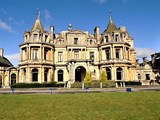
The camp includes a “stately home”, Halton House (HH). We were met there by Trixie, Halton House's Archivist, who took us in charge and showed us around. Although only 133 years old, Halton House has history, and Trixie can tell you a great deal about what went on there. She freely admits she has been researching the site for years but still keeps unearthing new titbits. And titbits they are because by all accounts HH could have been called “High Jinks House”. It was the place to party but only for the very rich and very famous – and for Royalty. Indeed in 1894 the first guest at the first party to celebrate the mansion’s ornate construction, completed from scratch in only three years, was the then Prince of Wales, Albert Edward who became a regular visitor, and King on the death of his mother some years later. It isn’t known for sure but its probably a safe bet that Queen Victoria never visited HH, because she certainly would not have been amused by the fun and frolics that apparently was its raison d’être; it was in fact the country home and discreet party venue of Alfred de Rothschild, who’s day job was a Director of the Bank of England.
It was a jolly place by all accounts and in fact still is; it’s a working home for RAF officers resident and visiting RAF Halton within its grounds, and includes their “Mess”. We have no doubt they try to keep up the building’s long standing traditions, although probably not in such lavish style.

The irony of Afghanistan - it seems the officers have a wry sense of humour; this recruitment poster is displayed on the wall behind their bar! Of course, Afghanistan was part of the UK's "Great Game" against the Russians even during Victorian times.
I did say HH was “ornate” didn’t I? Well, I don’t think that’s inaccurate, you only have to look up at the gold ceiling in the smoking room (yes, real gold, and original too), or the attention to detail on the banisters of the sweeping staircase, or the imposing chandelier in the grand hall to confirm that.
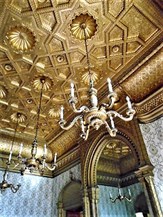
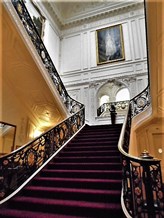
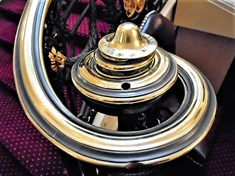
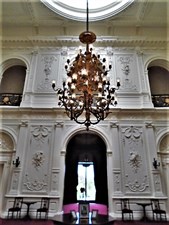
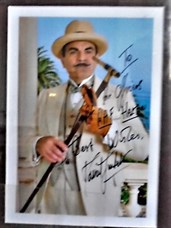
And lavish? I've already said the building was famous for its parties, and if you think “party bags”, that bane of some parent’s lives these days are a modern addition to party life you’d be wrong; the party bags given away by Alfred were something to behold and could include home made chocolates and fashionable scent for the ladies and Cuban cigars for the gentlemen. The building is still famous today, although in more subtle terms; it has been the location for scenes in many blockbusting films, “The World is not enough” (Pierce Brosnan) and “The Queen” (Helen Mirren) to name but two and it can be seen in countless TV series including “Poirot” (David Suchet) and “Silent Witness” (Amanda Burton), and yes, Downton Abbey.
Alfred de Rothschild may have been a banker but he was one of the good guys. He was a close friend of Lord Kitchener and just over one hundred years ago when war loomed over Europe once more, Alfred allowed his whole Buckinghamshire estate of many thousand acres to be used as a military training ground. That included a large flat area in the valley below HH, which soon became a home to a vital part of our fledgling air force, then known as The Royal Flying Corps, training its mechanics and engineers. Sadly Alfred died just before that war’s end. His heir however allowed the whole Halton estate to be purchased by the UK’s military and it has been part of the Royal Air Force ever since.
 Byfield & District RBL's Terry, Joy, Vernon, Bernard, Graham, Russ, Alison, Alan, Laurie, John & Tony outside Halton House. Photo by Trixie.
Byfield & District RBL's Terry, Joy, Vernon, Bernard, Graham, Russ, Alison, Alan, Laurie, John & Tony outside Halton House. Photo by Trixie.
Trixie then led us in convoy onto the Station proper (the area behind the wire) and delivered us into the hands of Francis, a softly spoken but extremely knowledgeable curator of The Trenchard Museum, on the side of the camp’s parade ground. Anyone who has been associated with the British military would be familiar with the wooden hut in which this was housed and yes, it was small but immaculately kept and well laid-out – and it was large enough to house a real Folland Gnat jet training aircraft, once made famous by our Red Arrows. Also inside were various tableaux depicting many aspects of RAF life from its early days through to the Second World War and beyond. It has guns galore, from Bren LMG to 30mm Aden cannon, and bombs old and new (well, actually the new one, half the size and twice the power, and laser guided too, was across the parade ground in our last port of call).
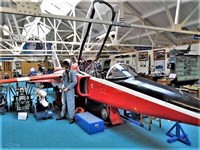
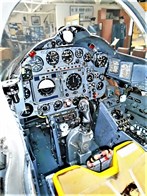
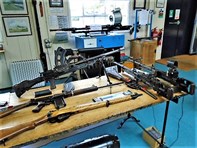
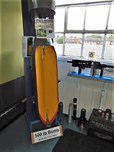
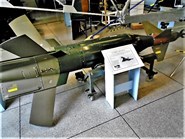
There were also real aircraft engines that had been cut-away to reveal how their parts moved, one of which was a multi-cylinder internal combustion rotary with a sleeve valve arrangement that had two of our number in apparent ecstasy. Francis seemed to know pretty much everything about all the exhibits and quietly explained to me that everyone wasn’t quite such a fan of sleeve valves but kept his council in deference to the excitement of others.
I should add that Hugh Trenchard, later Viscount and Marshal of the Royal Air Force, is accredited as being instrumental in establishing the RAF. Trenchard’s life is fascinating and could give our Chief Scout Bear Grylls a run for his money where adventure and overcoming adversity is concerned – look him up if you dare…
Then it was off to the nearby Airman’s Mess for a two course lunch; we arrived soon after 150 recruits had left (it was the weekend and many were on a pass) to find the place already spotless and with enough tasty grub left to satisfy any appetite.
HH had been fascinating, and the Trenchard Museum very informative but for many of us the highlight of our day was yet to come; across from the Trenchard Museum in one of the substantial buildings, built of brick in the 1920’s alongside the parade ground, was the James McCudden Flight Heritage Centre. Although this was a mini-museum too, and had everything from that modern bomb I spoke of, through more cut-away engines – this time all jets, hand built full size wooden aeroplanes and intricate models of very early aircraft (including a Farman similar to those string-bags my Grandmother used to help build at Graham White Aviation in Hendon – but I digress) it also had three Link Trainers AND their modern equivalent, an up to date flight simulator that we could actually use!
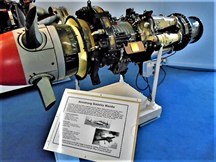
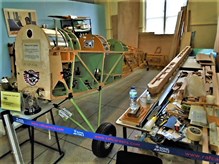
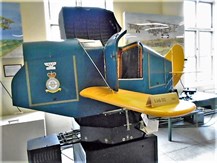
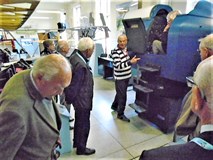
Bill was in charge here and like Trixie and Francis, he was another excellent communicator. He held us captive by his instructive account of Mr. Link’s magic Blue Box, which you sat in and “flew”, simulating wandering over the countryside using its instruments to navigate – with every move traced on a chart by a large triangular "mouse" outside, which automatically recorded what you were doing in pen and ink. Edwin Link of New York, USA developed the device in the early 1930’s of last century and it became a standard flight navigation training machine used world wide through to the fifties.
And then there was its modern equivalent to play with. This consisted of a seat in front of three flat video screens forming the cockpit windows. Controls included throttle levers and a trim wheel, flap selection, joystick and rudder pedals, and even wheel brakes. The software was for a De Havilland (Canada) Chipmunk single engine low wing monoplane training aircraft.
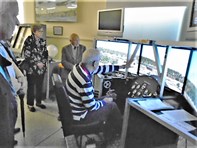
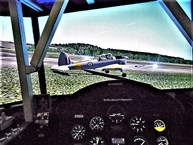
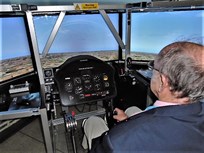
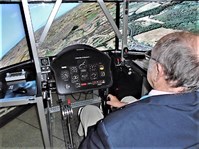
Bill proved to be a good instructor and soon had us taking-off, flying straight and level, doing turns and landing back at base. He was a cool, tolerant guy and full of praise for Chipmunk first timers, even when you had the aircraft rolling into the rough after a very bumpy landing (that's your scribe at the controls)! His encouragement reminded me of a recent physiotherapy session where my torturer said "you are doing very well" even when you know… But I digress, again.
The software had various scenarios to select, from flying around RAF Halton, to depictions over London and along the River Thames, and even including an aircraft carrier anchored in the Mersey.
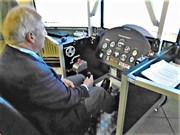
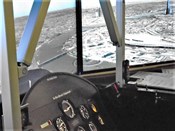



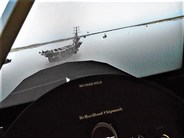 Here Bernard is flying our Chipmunk over London but after refueling at London City, Russ hopped her over to Liverpool, where his carrier awaited; maybe this is the first time anyone has landed a Chipmunk on an aircraft carrier?
Here Bernard is flying our Chipmunk over London but after refueling at London City, Russ hopped her over to Liverpool, where his carrier awaited; maybe this is the first time anyone has landed a Chipmunk on an aircraft carrier?
I must not end this entry in our “digital diary” without mentioning James McCudden VC, after whom this facility is named. James McCudden is an apt person of British history to be associated with RAF Halton because he started his career in the RFC as an air mechanic, having previously served in the Royal Engineers. Although engineering training is no longer on the curriculum at RAF Halton that was the RFC’s primary purpose here during World War 1. James McCudden soon converted to flying, initially as an observer, although his desire to become a pilot was at first frustrated by his prowess as an engineer; he was thought too valuable to lose in that regard. However in 1916 all that changed and he gained his wings, before the end of the war he became one of our fighter “Aces” claiming 57 victories. In April 1918 he was awarded the VC, adding to his MM and MC & Bar, tragically he died in July that year, just before the end of the war but in an air accident, not from enemy fire.
The death of a hero may be a sombre note on which to end but we mustn't let that cloud our otherwise rewarding visit and the superlative reception we experienced during Byfield & District Royal British Legion's day at Halton House and RAF Halton.